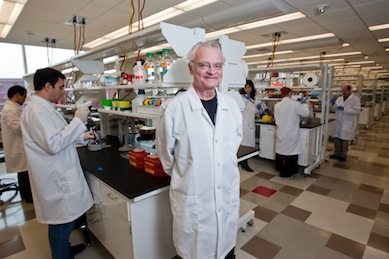HOUSTON, Aug. 23, 2012 – Scientists at the University of Houston (UH) have discovered what may possibly be a key ingredient in the fight against Parkinson’s disease. 
“LXRbeta performs an important function in the development of the central nervous system, and our work indicates that the presence of LXRbeta promotes the survival of dopaminergic neurons, which are the main source of dopamine in the central nervous system,” said CNRCS director and professor Jan-Åke Gustafsson, whose lab discovered LXRbeta in 1995. “The receptor continues to show promise as a potential therapeutic target for this disease, as well as other neurological disorders.”
To better understand the relationship between LXRbeta and Parkinson’s disease, the team worked with a potent neurotoxin, called MPTP, a contaminant found in street drugs that caused Parkinson’s in people who consumed these drugs. In lab settings, MPTP is used in murine models to simulate the disease and to study its pathology and possible treatments.
The researchers found that the absence of LXRbeta increased the harmful effects of MPTP on dopamine-producing neurons. Additionally, they found that using a drug that activates LXRbeta receptors prevented the destructive effects of MPTP and, therefore, may offer protection against the neurodegeneration of the midbrain.
“LXRbeta is not expressed in the dopamine-producing neurons, but instead in the microglia surrounding the neurons,” Gustafsson said. “Microglia are the police of the brain, keeping things in order. In Parkinson’s disease the microglia are overactive and begin to destroy the healthy neurons in the neighborhood of those neurons damaged by MPTP. LXRbeta calms down the microglia and prevents collateral damage. Thus, we have discovered a novel therapeutic target for treatment of Parkinson’s disease.”
Gustafsson, professor Margaret Warner, research assistant professor Xin-Jie Tan, and postdoctoral fellows Wanfu Wu and Yubing Dai authored the PNAS study, which is available at http://www.pnas.org/content/early/2012/07/18/1210833109.abstract.
###
About the University of Houston
The University of Houston is a Carnegie-designated Tier One public research university recognized by The Princeton Review as one of the nation’s best colleges for undergraduate education. UH serves the globally competitive Houston and Gulf Coast Region by providing world-class faculty, experiential learning and strategic industry partnerships. Located in the nation’s fourth-largest city, UH serves more than 39,500 students in the most ethnically and culturally diverse region in the country. For more information about UH, visit the university's newsroom.
To receive UH science news via e-mail, sign up for UH-SciNews.
For additional news alerts about UH, follow us on Facebook and Twitter.